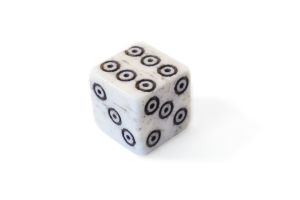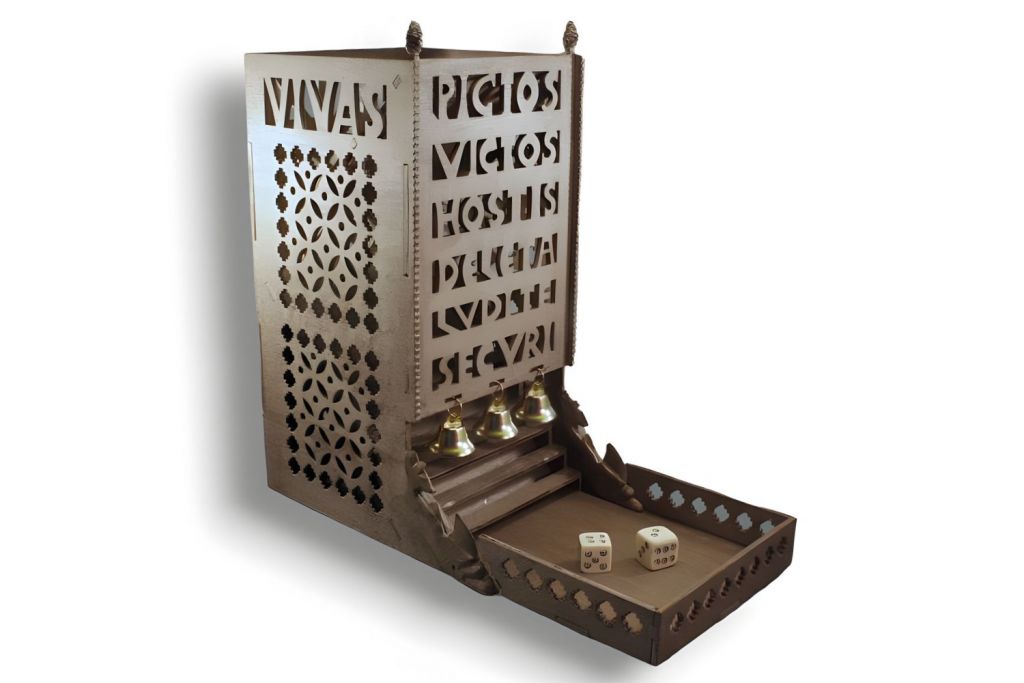Roman Dice Tower, kit
The kit contains a number of additional decorative elements, as well as bells at the tower exit. Stair treads are integrated into the lower section, while pine cones and profiled decorative strips adorn the front facade. Just like the lined dolphin figures, the pine cones can be customised with a file or hone. An additional 'safety barrier' prevents the cubes from falling off the table. As this feature is not included in the original, it can be fitted or removed as required. If you wish, you can of course paint the 20 cm high tower of cubes as the original or in your favourite colours.
Roman Dice Tower (Turricula)
Wooden construction kit of a Roman dice tower modelled on the find from Vettweiss-Froitzheim!
The dice tower is a further development of our reconstructions from 2015 and 2019 with numerous details:
* Additional decorative components and details such as bells, steps, pine cones, profiled mouldings and dolphin ornaments
* Can be customised by painting and finishing the dice and pine cones
* Additional "catch fence" prevents the dice from rolling off the table
* Have fun with modern dice games too
* Made from 100% European, untreated wood - sustainably produced
* Easy to build thanks to precisely pre-cut wooden parts
* Includes instructions and game board of the antique board game "Duodecim Scripta"
Dice, glue, paint and playing pieces are not included.
Assembly recommended for children aged 12 and over or under the supervision and guidance of an adult.
Roman Dice Tower (Turricula)
The kit contains many additional decorative components as well as bells at the exit of the tower. Steps are incorporated in the lower section, pine cones and moulded decorative strips adorn the front. Just like the doubled dolphin figures, the pine cones can be individually sculpted using a file or dremel. An additional "catch fence" prevents the cubes from falling off the table. As this component is not present in the original, it can be attached or removed as required. If you wish, you can of course also paint the 20 cm high dice tower like the original.The dice tower is not only suitable for Roman board games, but can also successfully prevent manipulation when rolling the dice in modern parlour games. It's also great fun!Colours and glue are not included, the pictures show assembly suggestions. This is a kit made of untreated 3mm plywood that needs to be assembled. All components are precisely pre-cut and all through-bridges are already worked out. This means that the kit can be assembled and glued together in a very short time.
Dice games in ancient Rome
Dice games were a popular pastime in ancient times, although even then gambling did not enjoy a good reputation. Sometimes people gambled not just for a few copper coins, but for entire fortunes, slaves or other possessions. Then as now, gambling addiction was a widespread vice that people tried to prevent. A law from republican times even equated winning a game with stolen goods to theft. Compliance with the ban was monitored by the Aedile police force.

However, illegal gambling flourished, especially in the numerous pubs, and was again tolerated during the frivolous Saturnalia holidays. Numerous ancient authors worried about the salvation of the gamblers, who not only ruined their own lives, but also acted as bad role models for young people, tempting them to play dice. Of course, dice games were also widespread in military circles, where pay was quickly redistributed.
Despite all the restrictions, even emperors indulged in dice games. Augustus, Domitian, Vitellius, Claudius - hardly anyone did not use the game of dice as a diversion. Caligula is even said to have resorted to unfair tricks as a gambler. However, hardly anyone would have dared to protest against this. Dice were also sometimes used in religious contexts to determine omens and portents.
Dice games could either be played with dice alone, or the dice were used to play a board game, as can be seen in some ancient illustrations. Duodecim Scripta", a form of today's game backgammon, was popular. Drinking games in which one player had to drink as much as his opponent rolled the dice.
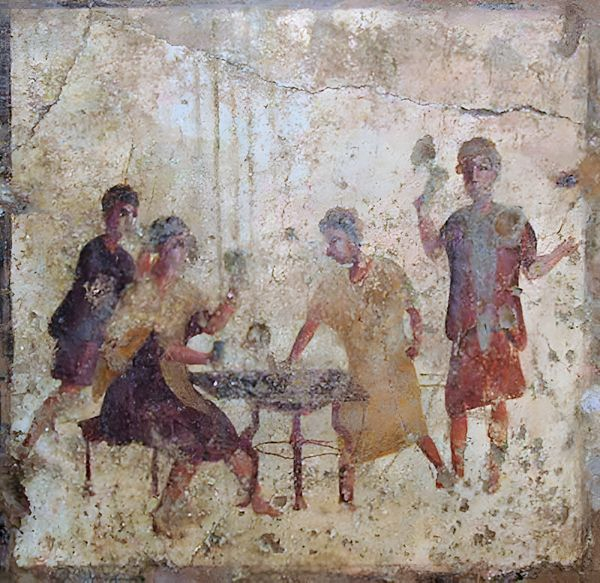
There were many different types of dice. In addition to the familiar six-sided dice, there were also those with eighteen or twenty sides, rod-shaped dice and those in the form of small figures. The hock bones of goats were also popular and were used as astragal dice as inexpensive playing pieces.
Wherever a lot of money was being gambled, deceit was not far away. In addition to the use of loaded dice, the throwing of the dice itself could also be skilfully manipulated. To prevent this, the Romans developed special dice cups and dice towers (turriculae), which were designed to prevent cheating.
Turricula Dice Tower - The original
The original was discovered in 1984 in Froitzheim on the site of a Roman Villa Rustica. In addition to the illustrations and a wooden artefact from Qustul in Egypt, this piece is the only surviving cube tower from Roman times. The Turricula from Froitzheim consists of 4 elaborately decorated bronze plates with several stairs in the interior, over which the dice jump. In addition to its pure function, the tower was also richly decorated. Two dolphin figures flank the exit of the dice tower, the top of which was probably originally decorated with battlements and small bronze pine cones. Unfortunately, only fragments of other decorative mouldings have survived. Three small bells seem to have been attached above the exit, which slowed down the dice and rang with each throw.
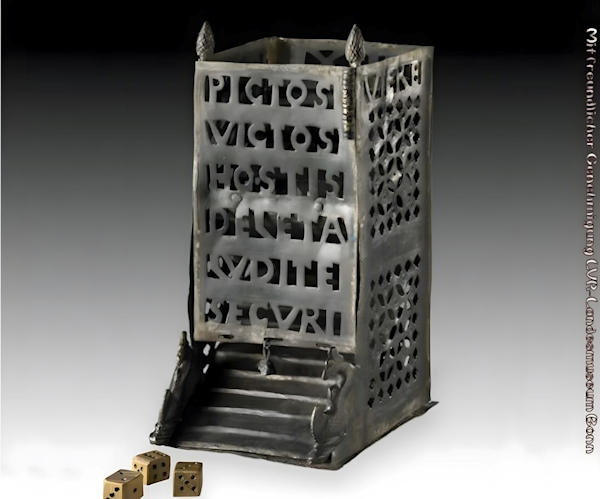
The dice tower bears the circumferential inscription "UTERE FELIX VIVAS", meaning "Use it happily, may you live". The inscription on the front reads "PICTOS VICTOS / HOSTIS DELETA / LUDITE SECURI": The Picts are defeated, the enemies destroyed, play safe. Based on the inscription, the dice tower can probably be dated to the 4th century, whereby a connection with the Picts Wars of Emperor Constans in 342/343 AD or the campaign of Emperor Theodosius in the northern borderlands in 368/369 AD is likely.
Duodecim Scripta - an antique dice game
The motto on the dice tower seems to refer to the Roman game "Duodecim Scripta". Three rows of 2 words were formed, each consisting of 6 letters. This results in 6 x 6 playing fields. There are surviving marble game boards with inscriptions such as LUDITE SECURI / QUIBUS AESAT / SEMPER INARCA ("Play with peace of mind, so that you always have money in your coffers") or SITIBI TESSEL / LAFARE TEGOTE / STUDIO VINCAM (actually Si tibi tessela faret ego te studio vincam, "Even if the luck of the dice is in your favour, I will defeat you by thinking").
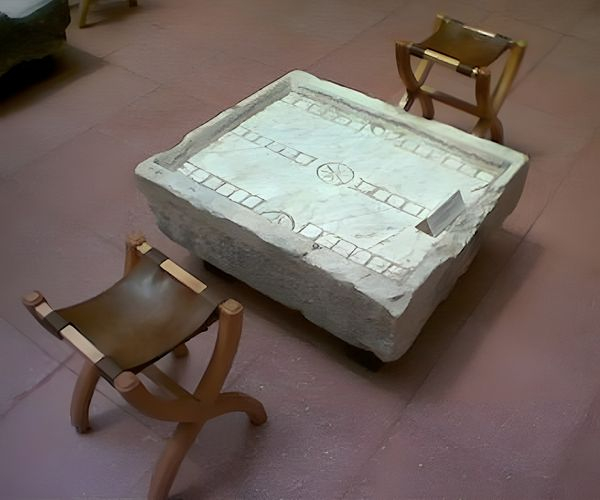
The examples show that grammar and spelling were sometimes used creatively to give the sentences the required form. The rules can be plausibly reconstructed on the basis of a board from Ostia, which divides the playing field into different groups using letters instead of a saying. The game was played with flat pieces numbered from 1 to 15 (I to XV). Both players placed their checkers on the squares in the centre row and had to try to move them across the board in a similar way to today's backgammon. The game was played with 2 or 3 dice, where the eyes could either be added to the move with a single checker or the corresponding eyes could be distributed over 3 checkers. It is also possible to make a move with 2 pieces, in which case the value of 2 dice had to be added together. The winner was the player who was the first to remove their pieces from the field.
| Delivery time | 1-2 weeks |
|---|---|
| weight | 0.750000 |
| size | Höhe / Height ca. 20 cm |
| Scale | 1:1 |
| Level of difficulty | 1- easy |
| Type of model | Others |
| Era | Romans |
| Material | Wood |

